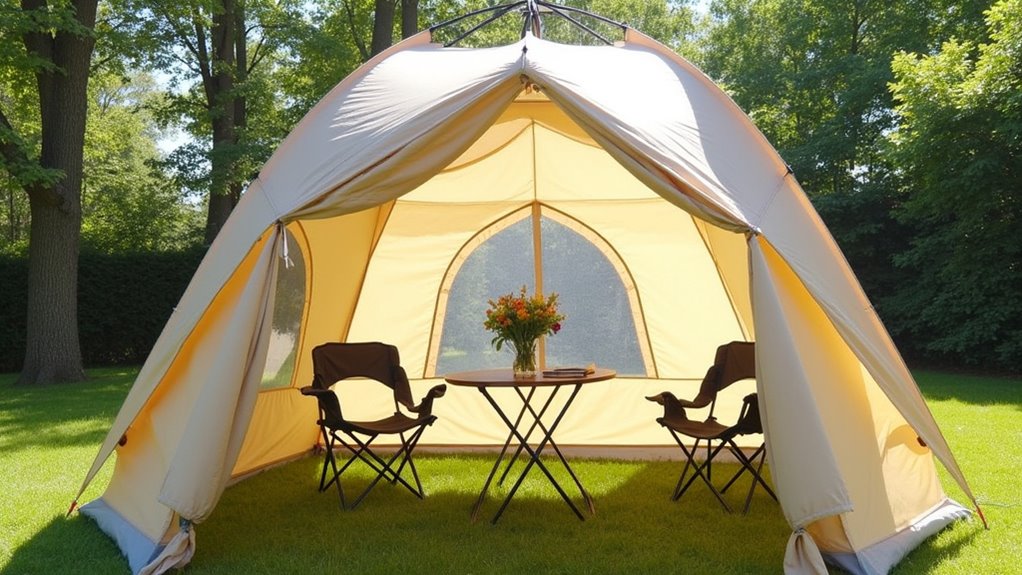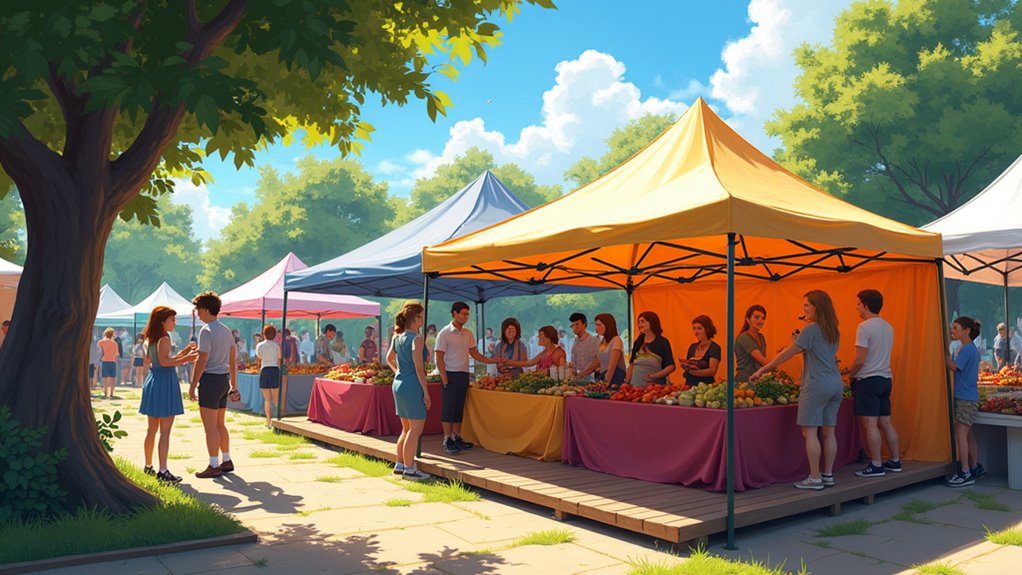How Big Is A 10X10 Tent
This post contains affiliate links. As an Amazon Associate, we earn from qualifying purchases.
A 10×10 tent measures 10 feet wide and 10 feet long, providing 100 square feet of covered space. This size easily accommodates a round table with 8 to 10 chairs or a banquet table with up to 10 chairs. Further details on how to maximize and properly set up this space will be explained later in the article.
Essential Facts in 30 Seconds
- A 10×10 tent covers 100 square feet.
- It measures 10 feet by 10 feet.
- Fits one round table with 8-10 chairs or one banquet table with 6-10 chairs.
- Peak height ranges from 9 feet 4 inches to 10 feet 9 inches.
- Entrance clearance is about 6 feet 7 inches.
Tent Dimensions and Area Coverage
A 10×10 tent covers 100 square feet of space. It measures exactly 10 feet by 10 feet. This area fits one round table with 8 to 10 chairs easily. You can also fit a banquet table with 6 to 10 chairs inside. A 10×10 tent is ideal for small to medium-sized events, providing a flexible space for gatherings, especially when considering the tent size requirements for accommodating a variety of guest numbers.
The tent’s peak height ranges from 9 feet 4 inches to 10 feet 9 inches. The entrance clearance is about 6 feet 7 inches tall. This height allows most people to enter comfortably. Most 10×10 tents have a single-piece top. This design makes setup quick and keeps the inside open. No center poles block the space, so your event feels roomy. Knowing these sizes helps you plan your event better. You can arrange tables and chairs to fit the tent perfectly. The tent’s design creates a welcoming and spacious area for your guests.
Setup Surfaces for 10×10 Tents
Setting up a 10×10 tent needs the right surface for stability and safety. Grass works well with stakes to hold the tent firmly. Properly staking a tent is crucial to ensure it remains secure and stable in various conditions.
Asphalt and concrete don’t allow stakes to go in. Use heavy bags or plates to keep the tent steady on these hard surfaces. Each surface needs different tools and steps. Prepare well to make your tent safe and strong. When securing a tent on various surfaces, consider the terrain type for optimal stability and safety.
Grass Ground Setup
Set up a 10×10 tent on grass with care.
Pick a flat spot without rocks or sticks. Remove grass and debris to make the ground smooth.
Check the soil; avoid soft or muddy places. Push stakes into the ground to test if it holds well.
Use strong tent stakes that go 12 to 36 inches deep. Place stakes about 5 feet from the tent edges.
Add weight for windy days—30 to 125 pounds per leg works well. Use weatherproof sandbags or heavy plates to keep the tent steady.
This way, your tent stays safe and secure.
Asphalt Surface Requirements
Asphalt surfaces are hard and don’t allow tent stakes. Use ballast weights to hold your 10×10 tent in place. At least 200 pounds of weight work best. Spread weights evenly on all four legs.
For calm weather, each leg needs 50 pounds. When wind speeds reach 30-50 mph, add 75 to 125 pounds per leg. Use concrete blocks, sandbags, or special weighted footplates.
Check that the asphalt is flat and clean before setting up. Tie ballast tightly to the tent legs for safety. Check the tent often to keep it steady during your event.
Concrete Installation Guidelines
Concrete surfaces provide a strong base for a 10×10 tent. Secure each tent leg with 35 to 50 pounds of weight.
Use concrete blocks, water barrels, or buckets filled with concrete, sand, or water. Balance weights evenly around the tent to stop it from moving.
Check the concrete for cracks and clean off any dirt or debris. Lift heavy weights with help from others.
Check all anchors often to keep the tent stable during your event. Safety first.
Materials and Durability Features
A 10×10 tent must have strong materials and good durability. Polyester fabric works well. It’s light and resists water. Coating it with PVC makes it last longer. Additionally, waterproof coatings are crucial for protecting against moisture.
Oxford fabric also suits tents. It resists tears and rough use. Aluminum frames are strong but light. Steel frames withstand strong winds better. Tents with UV and waterproof coatings last through bad weather. Check your tent often for weak spots. Dirt can damage the protective coatings.
Reinforced joints and thick floors help tents stay strong. These features make sure your tent lasts many years. Additionally, using customizable designs can enhance the overall durability and appeal of your tent setup.
Design and Layout Flexibility

Setting up a 10×10 tent offers many layout options.
Divide the space into zones for greeting guests, handling transactions, and showing products.
Place tables at the front to make access easy.
Keep the center open for activities and movement.
This design boosts engagement and works smoothly.
Smart layouts help you use every inch well.
Event Layout Options
A 10×10 tent gives many ways to arrange your event space. Good layouts help guests move easily and stay interested. Open-front tents let people walk in quickly.
L-shaped tables make cozy spots for talks. Island layouts have tables in the middle with space all around. On rainy days, move tables inside the tent to keep products dry.
Leave enough space between tables for easy walking. Use modular tables and add-ons to change the setup fast if the weather shifts.
Each layout affects event success. Plan your space carefully to get the best results.
Customization Possibilities
A 10×10 tent offers many ways to customize your event space.
Use strong fabrics like 600 denier acrylic-coated polyester for good weather protection. Full-color sublimation printing shows your brand clearly. Match Pantone colors for bright, eye-catching designs.
Add large valances to make your tent stand out. The frame adjusts in height to fit different needs. Add side walls for privacy or flag holders to catch attention.
Mix these features to build a tent that fits your brand and event perfectly.
Space Utilization Strategies
Maximize space in a 10×10 tent with smart planning and layout.
Use a U-shape design to boost customer interaction and allow access from many sides. Place the main display at the center-back for best visibility and smooth flow.
Choose small furniture like stools to save floor space for product displays. Add string lights to brighten the tent and highlight important areas.
Keep enough space between tables for easy walking paths. An open and friendly layout invites quick chats and better visitor engagement.
These steps improve both function and the overall tent experience.
Common Uses and Applications

Tents sized 10×10 feet offer many useful functions in different places.
Businesses use these tents at outdoor trade shows and promotional events. They show logos and signs clearly. Setup is fast and easy. Vendors use them at farmers’ markets and craft fairs. Additionally, these tents can be secured with stakes to withstand wind and weather during outdoor events.
Sports fans and coaches find these tents helpful during tournaments. They provide shade and shelter. The tents are light and easy to carry.
Families enjoy them at backyard barbecues and beach trips. They fit small groups comfortably.
Community events like weddings and festivals also use 10×10 tents. They meet space rules and protect people from rain or sun.
These tents work well for many outdoor needs. They make events better and more comfortable. Additionally, having essential gear for tent camping ensures that your experience remains enjoyable and well-prepared, regardless of the event.
Comparison of Tent Models and Options
Selecting the right 10×10 tent changes your whole experience. Different tents fit different needs. Frame materials affect weight, strength, and ease of setup. Here is a clear comparison:
| Tent Type | Frame Material |
|---|---|
| Pop-Up Canopy | Aluminum (lightweight) |
| Classic Frame Tent | Heavy-duty Steel |
| Canvas Camping Tent | Flex-bow Steel Rods |
| Commercial Tent | PVC Vinyl (heavy) |
Pop-up canopies are quick to set up and easy to carry. Classic frame tents use strong steel, perfect for tough weather. Canvas tents feel cozy and use flexible steel rods. Commercial tents have heavy PVC vinyl, offering high durability. Additionally, event tents are versatile and can be customized to suit various occasions.
Think about weight and how easy it is to move your tent. Also, check if the tent fits your space needs inside. High peak tents give more headroom. Some tents let you add walls or windows. These choices help you make your event comfortable and smooth. Additionally, consider the tent’s waterproof rating as it can significantly affect your experience during inclement weather. Pick a tent that fits your event style and weather conditions best.
Frequently Asked Questions
How Many People Can Fit Under a 10X10 Tent?
A 10×10 tent holds about 8 to 10 people seated comfortably. For standing events, it fits 12 to 20 guests easily. This size works well for small parties, markets, or shade at outdoor events. Tables and chairs reduce space, so plan accordingly. Keep in mind weather and extra gear when estimating capacity.
Can a 10X10 Tent Withstand Strong Winds?
A 10×10 tent can stand strong winds up to 25 MPH with proper anchoring. Use heavy-duty stakes and ropes to keep it steady. Some tents made for tough weather handle winds over 30 MPH. Always check the tent’s material and frame strength. Secure the tent well for safety and stability during windy days.
What Is the Weight of a 10X10 Tent?
A 10×10 tent usually weighs between 42 and 68 pounds. The weight depends on the materials used. Aluminum frames are light and easy to carry. Steel frames are heavier but strong and steady. Some tents come with extra features that add weight. Always check the tent’s weight before buying. This helps you carry it comfortably.
How Long Does It Take to Set up a 10X10 Tent?
Setting up a 10×10 tent usually takes about 10 minutes. Clearing the space first helps a lot. Working with a partner speeds things up too. Practicing setup before the event makes you faster. Simple steps like these save time and hassle. You can have your tent ready quickly and easily!
Are 10X10 Tents Suitable for Winter Events?
10×10 tents work well for winter events. Strong canvas tents block cold wind. They do not keep heat inside by themselves. Use heaters inside the tent to stay warm. Make sure to tie down the tent firmly. Snow and wind can make tents unstable. Add sidewalls to stop chilly drafts. These tents offer good shelter and space. Perfect for small groups or food stands. Keep safety in mind with heating devices. You can enjoy winter events with proper setup.
Conclusion
A 10×10 tent provides 100 square feet of space. This size works well for many uses. It fits small groups, market stalls, or outdoor parties easily. The tent usually stands about 8 to 10 feet tall. Materials like steel or aluminum frames with waterproof fabric keep it strong and dry. You can set it up quickly for shade or shelter. This tent size offers a good balance of space and portability. It suits events like fairs, picnics, or trade shows. Choosing the right tent depends on your needs and weather conditions. A 10×10 tent can improve comfort and protect you from sun or rain. This practical size helps you enjoy outdoor activities with ease.
